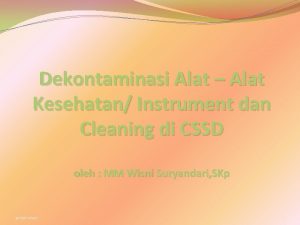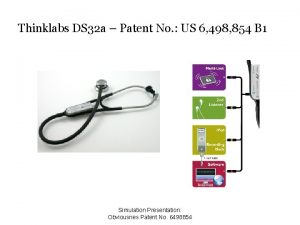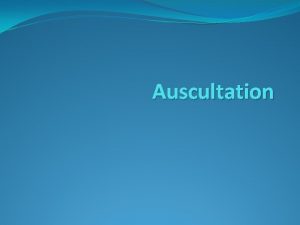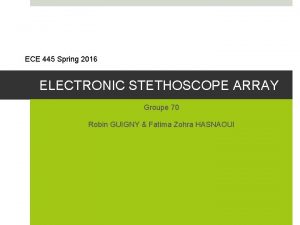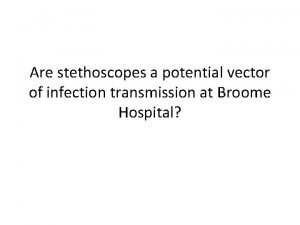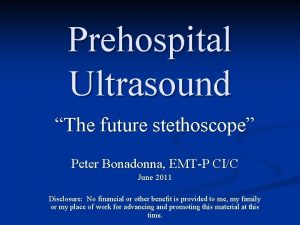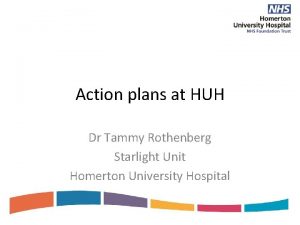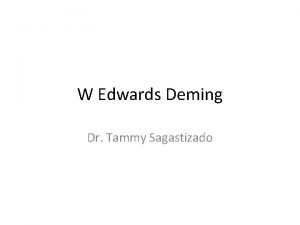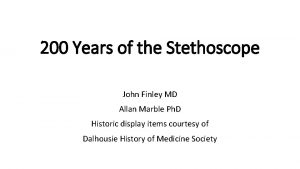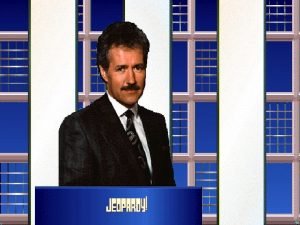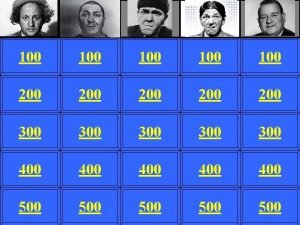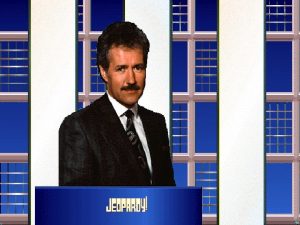200 Years of the Stethoscope John Finley MD
















- Slides: 16

200 Years of the Stethoscope John Finley MD Allan Marble Ph. D Historic display items courtesy of Dalhousie History of Medicine Society

Who was Rene Laennec? He was born in Quimper, Brittany in 1781. He studied medicine in Nantes and then Paris. An outstanding student, he won prizes in medicine and surgery and published several papers before graduating. He was a consulting physician at the Hopital Necker from 1816, where his interest in TB (which he contracted later) kindled his interest in listening to the chest. He died in 1826.

Statue of Laennec in Quimper, Brittany

Laennec using his stethoscope


Adoption of the stethoscope • 1816 -Laennec invents stethoscope • 1819 -De L’Auscultation Mediate published • 1830 -adoption in Quebec (Dr Beaubien) • 1836 -adoption in NS (Dr Black) • 1851 -Binaural stethoscope, Dr Leared (Ireland) • 1948 -Sprague Rapaport acoustic design (US) • 1970 -first electronic stethoscope (US)

William Osler’s personal copy of Laennec’s first edition

What does the word “stethoscope” mean? Coined by Laennec, it derives from the Greek stetho, chest, and scope, examine

How did Laennec get the idea for the stethoscope? In 1816 he was asked to evaluate a young woman with “general symptoms of a diseased heart”. Palpation of the heart and percussion revealed nothing helpful. He was reluctant to perform auscultation with his ear directly on the chest, as was the technique in that era, because of her age, sex and “plumpness”. In his words…

“I recalled a well known acoustic phenomenon: if you place your ear against one end of a wood beam the scratch of a pin at the other end is distinctly audible. It occurred to me that this physical property might serve a useful purpose in the case I was dealing with. I then tightly rolled a sheet of paper, one end of which I placed over the precordium (chest) and my ear to the other. I was surprised and elated to be able to hear the beating of her heart with far greater clearness than I ever had with direct application of my ear. I immediately saw that this might become an indispensable method for studying, not only the beating of the heart, but all movements able of producing sound in the chest cavity”

Following this experience Laennec spent several years improving the stethoscope using a wooden tube, as seen in the display.

How did the stethoscope influence medical practice? Adopted gradually over 50 years in Western countries, with some reluctance particularly in the US, it was the first and primary diagnostic device for the physical examination of the heart, lungs and to some extent abdomen. The location and type of pulmonary abnormalities could be quite accurately detected by listening to the breath sounds on the chest. Similarly various heart sounds began to be correlated with specific cardiac abnormalities. More accurate diagnosis of disease, beyond identification of symptoms, was an important step toward effective treatment. Even today with remarkable developments of diagnostic technologies, the physical examination, including careful listening to the heart and lungs, is most important in establishing an initial diagnosis. In many cases careful evaluation of sounds is sufficient for an accurate diagnosis, while in others technology is needed to confirm the diagnosis.

What is the future of the stethoscope? The development of many new diagnostic technologies such as bedside cardiac ultrasound are proposed by some to replace the use of the stethoscope. While useful in certain situations, these devices are not suitable for routine physical examination by general physicians. Specialized training is required, accurate studies take time, and in children many audible cardiac murmurs have normal ultrasound findings. Of course ultrasound does not penetrate the lungs and is of no use in chest evaluation. Careful training and maintenance of skill with the stethoscope is essential, but its capability for rapid, inexpensive evaluation in both healthy and abnormal patients suggest it will be used for many years to come.

Wooden stethoscope c 1830

Early binaural stethoscope c 1860

References • Duffin J. To see with a better eye: a life of RTH Laennec. 1998. Princeton University Press, Princeton NJ • Segall HN. L’introduction du stethoscope et de l’auscultation clinique au Canada. L’Union Medical du Canada 1968; 97: 1115 -1117 • Chang L. Development and use of the stethoscope in diagnosing cardiac disease. Amer J Cardiology 1987; 60: 1378 -1382
 Scientific notation
Scientific notation Menurut dr earl spaulding stetoskop termasuk kategori alat
Menurut dr earl spaulding stetoskop termasuk kategori alat Thinklabs ds32a digital stethoscope
Thinklabs ds32a digital stethoscope Medical term for listening with a stethoscope
Medical term for listening with a stethoscope Robin guigny
Robin guigny Antimicrobial stethoscope covers
Antimicrobial stethoscope covers Peter bonadonna
Peter bonadonna Lynne finley
Lynne finley I5 bandit
I5 bandit Dr tammy finley
Dr tammy finley Dr tammy finley
Dr tammy finley Jocelyn finley
Jocelyn finley Dr tammy finley
Dr tammy finley Sheep years to human years
Sheep years to human years 300 solar years to lunar years
300 solar years to lunar years Four score and ten years ago
Four score and ten years ago The earth 200 million years ago
The earth 200 million years ago

